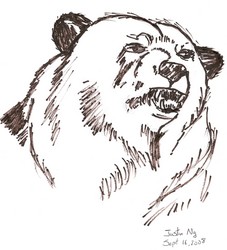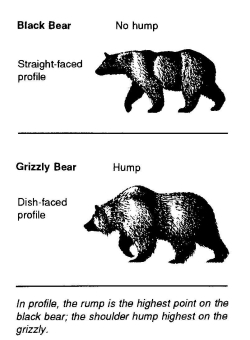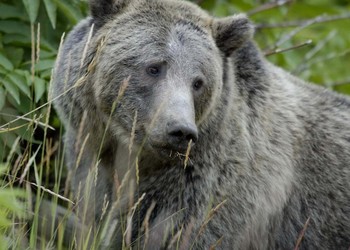Grizzly Bear Love


Edgar preparing to fight the other bear by looking verocious. © Justin Ng
A long, long time ago, in the mountains of British Columbia, there lived a big grizzly bear named Edgar. Edgar had just awoken from a long, but relaxing, five months in a very deep sleep that approached but was not quite hibernation. Edgar had dug himself a nice den, away from the harsh winters of Canada, to sleep peacefully. He had used his long claws and powerful shoulders to make himself a den, and his thick fur helped him to stay warm.
Let me tell you about Edgar. Edgar was just like all the other bears. He woke up everyday, bright and early, grabbed a few berries and plants, and headed off to wander the mountains and forests, occasionally stopping to excrete some fecal matter. For lunch and dinner, Edgar would wander through streams and rivers, hoping to find salmon and other types of fish that he could feast on. Catching fish required effort, and this was one of Edgar’s favourite activities to pass the time. Edgar thought this was going to be another year of simply foraging, eating, and sleeping. It was seven years ago since Edgar was born. He had lost his parents at a very young age and spent most of his time alone. Edgar thought this was going to be just another year alone. However, his luck was about to change.
One day, Edgar was walking along a river, just having caught his second salmon. Fully satisfied with his meal, Edgar trotted slowly along the river, minding his own business. Suddenly, Edgar picked up a scent that he had never smelt before. This scent sent shivers down his fur-coated skin. It was the most beautiful thing he had ever experienced. He followed the scent for some time, slowly trotting through the mountains of British Columbia until he saw her. The most beautiful sow he had ever seen stood majestically in front of him, quietly snacking on some berries. He checked his snout to make sure his breath was okay, and began walking towards her until he heard a sound coming from behind him. Suddenly, another bear came strutting in, head held high, walking around like he owned the forest. Edgar paused for a moment, trying to figure out what was going on. He then realized that the other bear was trying to steal his sow. He growled loudly and charged at the other bear knocking him over. Edgar and the other bear began to exchange blows, viciously clawing at one another. Edgar was able to land a well-timed blow that stunned the other bear. The other bear walked off slowly, ashamed that Edgar had defeated him. Edgar then approached the sow, and there was an instant connection between them. The sow’s name was Daisy and after a few months of getting to know each other, Edgar and Daisy fell in love with each other, and ultimately, mated with each other. Right before the long months of winter, Edgar and Daisy found a nice cave together to hibernate.
After months of long hibernation, Edgar awoke to find a very big surprise awaiting him. Edgar and Daisy had two beautiful little cubs. The two cubs and the mother lived happily ever after together. Edgar had wandered off to gorge himself on more plants and salmon, but he was happy too.
The Grizzly Bear (Ursus arctos horribilis)


A comparison between a Grizzly Bear and Black Bear in terms of body shape. © Alberta Sustainable Resource Development
General Description
A subspecies of the brown bear, the grizzly bear is recognizable by it’s proportionately larger claws and a cranial profile resembling the polar bear. Grizzly bears reach weights of 136-680 kilograms. The males are much larger than the females, and grizzly’s coloring ranges widely, from blond to deep brown. The grizzly gets its name from its fur, which is lighter and has a more “grizzled” look than that of brown bears. Grizzly bears have a hump over their shoulders which is a muscle mass used to power the forelimbs when digging. Grizzly bears hibernate in the winter, after having built up reserves of fat to nourish themselves for the long months they sleep. Even though they can be easily awoken, they hibernate in protected spots such as caves, hollow logs, or crevices. Bears are omnivores and eat a variety of plants, fungi, berries, as well as fish, insects, and small mammals.


A grizzly bear in its common habitat eating plants for food. Image courtesy U.S. Fish and Wildlife Service
Habitat
Grizzly bears are found throughout much of Western Canada and Alaska and reaching into some portions of the 48 lower states. Grizzly bears usually prefer to be around streams, lakes and rivers where salmon are plentiful. They need large territories (80 to 480 square kilometers for females; 320 to 800 square kilometers for males). The more abundant the food source, the smaller the territories need be.
Adaptations to the Environment
Grizzly bears hibernate during the North’s long, inhospitably cold winters, and their thick fur helps them to stay warm. The grizzly bear's long claws and powerful shoulders make it an expert digger, which makes creating winter dens and finding food much easier.
Hibernation
Grizzly bears are not true hibernators which requires a significant drop in body temperature and breathing rate during the period of hibernation. The Grizzly’s drop in body temperature is only a few degrees, and its respiration rate only decreases slightly. It is more accurate to describe Grizzly’s behaviour during the winter months as a dormant state. Grizzlies are alert and easily roused during this period. This dormancy allows the bear and its offspring to survive the long winter months.
Reproductive Characteristics
Every other year, in the spring during the months of May or June, grizzly bears will mate and will reproduce usually between the months of January and February. Some grizzly bears wait almost 7 years before they become sexually mature. Bears follow a particular mating ritual. Once females (sows) become sexually mature, they leave scent trails, which the males follow. This can lead to potentially violent showdowns, as multiple males can be attracted to one female’s scent. After this, the mating pair spend time getting to know each other. Mating between bears lasts from minutes, to up to an hour.
Females produce one to four young (most commonly two), which are small and weigh only about 0.5 kilograms. Like members of the weasel family, grizzly bears experience delayed implantation where the fertilized egg will become a blastocyst and floats freely in the uterus of the female bear for several months. In most grizzly bear populations, the cub will remain with the sow for one year, den with her the following winter, and leave the next summer. These characteristics suit the organism’s habitat very well. Bears go into hibernation during the months of winter. When the female comes out of hibernation, she is ready to give birth.
Classification
- Kingdom: Animalia
- Phylum: Chordata
- Class: Mammalia
- Order: Carnivora
- Family: Ursidae
- Genus: Ursus
- Species: Ursus arctos
Importance to the Ecosystem
The grizzly bear is a very important organism and has many positive effects on the surrounding ecosystem. Since the grizzly bear is a predator and is at the top of the food chain, it indirectly influences the rest of the ecological community, impacting the trophic levels and other organisms in the area.
Endangered or Common Species?
The grizzly bear is listed as threatened in the contiguous United States and listed as endangered in Canada. The main reason for the grizzly bear’s decrease in range and population is due to human activity. In Alaska and parts of Canada, it is legal to shoot grizzly bears for sport. The grizzly bear is listed as endangered because during the 1840s, during the gold rush, people established settlements in the bears' territory. People killed bears for their meat, their fur, and because they were seen as a threat to humans. Grizzly bears are also susceptible to being killed by cars or trains as they graze roads and train tracks for food.
Quiz - Test your knowledge on Grizzly Bears
- The grizzly bear is a subspecies of the:
- Black Bear
- Brown Bear
- Polar Bear
- Panda Bear
- Grizzly bears are
- Omnivores
- Herbivores
- Carnivores
- Scavengers
- Grizzly bears hibernate for…
- 4 months
- 5 months
- 10 months
- None of the above.
Answer; 1. b, 2. a and d, 3. d
Information on the Internet
- Grizzly Bear - Wikipedia, the free encyclopedia This is a great website that gives a good overview of the Grizzly Bear, as well as its major characteristics. It also provides links to important parts of the body, as well as high-quality photos.
- Grizzly Bear - The Animals of British Columbia, Canada A great website that provides a good general understanding for those just wanting to learn the basics of the Grizzly Bear.
- Grizzly Bear: Natrual History Notebooks online from the Canadian Museum of Nature A great website that has a brief introduction to the Grizzly Bear. However, this site is an excellent source of high-quality Grizzly Bear pictures.
- Grizzly Bear Information A wonderful fact sheet about the biology, ecology, and conservation status of the Grizzly Bears in British Columbia.
- Grizzly Bear Alliance A great website that deals with the diminishing number of Grizzly Bears in Alberta, Canada. It also gives information on what you can do to help Grizzly Bears from becoming extinct.



 Go to quick links
Go to quick search
Go to navigation for this section of the ToL site
Go to detailed links for the ToL site
Go to quick links
Go to quick search
Go to navigation for this section of the ToL site
Go to detailed links for the ToL site